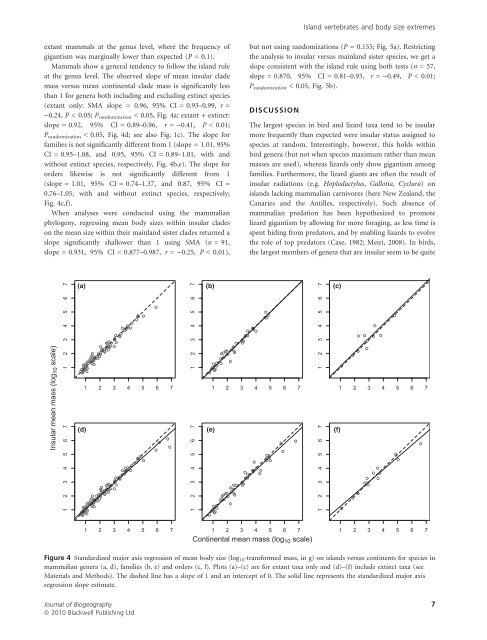Slaying dragons: limited evidence for unusual body size evolution ...
Slaying dragons: limited evidence for unusual body size evolution ...
Slaying dragons: limited evidence for unusual body size evolution ...
You also want an ePaper? Increase the reach of your titles
YUMPU automatically turns print PDFs into web optimized ePapers that Google loves.
extant mammals at the genus level, where the frequency of<br />
gigantism was marginally lower than expected (P = 0.1).<br />
Mammals show a general tendency to follow the island rule<br />
at the genus level. The observed slope of mean insular clade<br />
mass versus mean continental clade mass is significantly less<br />
than 1 <strong>for</strong> genera both including and excluding extinct species<br />
(extant only: SMA slope = 0.96, 95% CI = 0.93–0.99, r =<br />
)0.24, P < 0.05; Prandomization < 0.05, Fig. 4a; extant + extinct:<br />
slope = 0.92, 95% CI = 0.89–0.96, r = )0.41, P < 0.01;<br />
P randomization < 0.05, Fig. 4d; see also Fig. 1c). The slope <strong>for</strong><br />
families is not significantly different from 1 (slope = 1.01, 95%<br />
CI = 0.95–1.08, and 0.95, 95% CI = 0.89–1.01, with and<br />
without extinct species, respectively, Fig. 4b,e). The slope <strong>for</strong><br />
orders likewise is not significantly different from 1<br />
(slope = 1.01, 95% CI = 0.74–1.37, and 0.87, 95% CI =<br />
0.76–1.05, with and without extinct species, respectively;<br />
Fig. 4c,f).<br />
When analyses were conducted using the mammalian<br />
phylogeny, regressing mean <strong>body</strong> <strong>size</strong>s within insular clades<br />
on the mean <strong>size</strong> within their mainland sister clades returned a<br />
slope significantly shallower than 1 using SMA (n = 91,<br />
slope = 0.931, 95% CI = 0.877–0.987, r = )0.25, P < 0.01),<br />
Insular mean mass (log 10 scale)<br />
but not using randomizations (P = 0.155; Fig. 5a). Restricting<br />
the analysis to insular versus mainland sister species, we get a<br />
slope consistent with the island rule using both tests (n = 57,<br />
slope = 0.870, 95% CI = 0.81–0.93, r = )0.49, P < 0.01;<br />
Prandomization < 0.05, Fig. 5b).<br />
DISCUSSION<br />
(a) (b) (c)<br />
(d) (e) (f)<br />
The largest species in bird and lizard taxa tend to be insular<br />
more frequently than expected were insular status assigned to<br />
species at random. Interestingly, however, this holds within<br />
bird genera (but not when species maximum rather than mean<br />
masses are used), whereas lizards only show gigantism among<br />
families. Furthermore, the lizard giants are often the result of<br />
insular radiations (e.g. Hoplodactylus, Gallotia, Cyclura) on<br />
islands lacking mammalian carnivores (here New Zealand, the<br />
Canaries and the Antilles, respectively). Such absence of<br />
mammalian predation has been hypothe<strong>size</strong>d to promote<br />
lizard gigantism by allowing <strong>for</strong> more <strong>for</strong>aging, as less time is<br />
spent hiding from predators, and by enabling lizards to evolve<br />
the role of top predators (Case, 1982; Meiri, 2008). In birds,<br />
the largest members of genera that are insular seem to be quite<br />
Continental mean mass (log 10 scale)<br />
Island vertebrates and <strong>body</strong> <strong>size</strong> extremes<br />
Figure 4 Standardized major axis regression of mean <strong>body</strong> <strong>size</strong> (log 10-trans<strong>for</strong>med mass, in g) on islands versus continents <strong>for</strong> species in<br />
mammalian genera (a, d), families (b, e) and orders (c, f). Plots (a)–(c) are <strong>for</strong> extant taxa only and (d)–(f) include extinct taxa (see<br />
Materials and Methods). The dashed line has a slope of 1 and an intercept of 0. The solid line represents the standardized major axis<br />
regression slope estimate.<br />
Journal of Biogeography 7<br />
ª 2010 Blackwell Publishing Ltd


